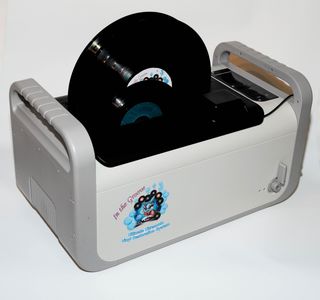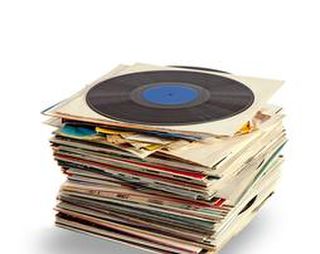KIRMUSS-RCM Ultrasonic Cleaner - Record Cleaning and Storage
|
|
Information
Kirmuss KA-RC-1
RESTORE your 33-1/3, 45's and 78"s. - CLEAN 2x 33's, 1x 45 and 1x 78 simultaneously!
The Editors at THE ABSOLUTE SOUND remarked his product was " Best Analog Accessory of Show".
THE ABSOLUTE SOUND: About our ultrasonic record restoration system:the "Most Significant Product Introduction (AXPONA 2018); Kirmuss Audio’s "In The Groove Ultimate Ultrasonic Vinyl Restoration System", makes the process of using this technology more affordable.”
Kirmuss, an audiophile and believer in affordable solutions and technology and holder of 5 Patents in technology and 6 patent applications pending introduced his invention which is priced at several thousands of dollars below other ultrasonic cleaning machines. This innovation makes record restoration available to everyone without a price premium and saw immediate market reaction.
NOT ALL ULTRASONICS WASH YOUR RECORDS SAFELY: SPECIFY 35 KHz! "Sonically speaking", the higher the frequency, the smaller the bubbles, smaller the bubbles, they enter small crevices easier but a RECORD CONTRARY TO BELIEF IS NOT A SMALL CREVICE. MINUTE DETAILS WITHIN THE GROOVE PROVIDE TIMBER AND THE EXCELLENCE OF ANALOG. THESE INDENTATIONS SHOULD NEVER BE REMOVED! One of the critical KIRMUSS differences, it wont deteriorate your records like others on the market will, in fact just the opposite, KIRMUSS restores as well as cleans records.
In 3 years of testing, 35 kHz is the sweet spot, does not remove these details and does not "smoothen" the grooves as would a poorly designed record cleaner leaving a residue which has the same effect. Not 45, not 80, not 90 kHz. NEVER 120 kHz or higher. All are proven to damage records over time. Much misinformation out there: We have in house experienced engineers familiar with ultrasonic generation. 35 kHz is gentle yet powerful to do the job!
A Primer on Sonic Technology:
Under pressure of continuous vibration by the ultrasonic generator at the bottom of the tank bubbles generated rise and stretch and compress at a fast rate. Once they reach a certain size as determined by the frequency and strength of the sound waves produced the bubbles lose structural integrity and collapse violently. When these implosions happen near the surface of an object such as a record, the bubbles emit high-powered streams of plasma that travel at more than 500 miles per hour and collide with, agitate and remove even very tiny particles and substances from the record's surface. Using a surfactant attracts further these bubbles to the record. (For new records, 40 mL of 70% alcohol per 6 L of distilled water to remove record pressing residue, our 1% propanol surfactant brushed in for mildly to generally abused records).
CALLED CAVITATION:
In an ultrasonic cleaning machine, explosions occur millions of times per second, removing contaminants. Bubble size relates to how much energy is released when they implode. That’s why a higher frequency produces less intense cleaning, (smaller bubbles) but because a higher frequency yields more bubbles it’s a better choice for cleaning parts with very tiny features such as blind holes, channels and threads. This a danger for vinyl and shellacked records.
SMALL BUBBLES DAMAGE THE DEPTH OF THE GROOVE REMOVING TIMBER AND HIGH FREQUENCIES. THE BEST ULTRASONIC FREQUENCY AFTER 3 YEARS OF TESTING IS 35 kHz WITH A MAX TEMP OF 95 DEG F.
Higher frequencies such as 100, 125, 130 kHz are used for fine cleaning jobs as they enter small surfaces including microelectronics, printed circuit boards, medical and precision optics. powerful explosions remove post manufacturing matter and dirt. The 35 kHz frequency has a good combination of power, penetration, and especially very even energy distribution and can successfully address most cleaning applications when combined with a properly-engineered cleaning system and also does not damage the stainless steel basin as do higher frequencies.
MORE MYTHS REVEALED:
AS TO OTHER SYSTEMS CLEANING 6, 8, 12 OR MORE RECORDS AT A TIME AND UNDERSTANDING SYSTEM SELECTION. THE KIRMUSSAUDIO SYSTEM HAS ITS RECORDS SPACED AT THE CORRECT DISTANCE BETWEEN EACH OTHER TAKING ULTRASONIC FREQUENCY, ULTRASONIC POWER TO THE CERAMIC SONIC TRANSDUCERS LOCATED AT THE BOTTOM OF THE STAINLESS STEEL BASIN WITH MEASURED BUBBLE GENERATION AND THE RESULTING CAVITATION EFFECT TAKEN INTO CONSIDERATION.
KIRMUSS THUS ENGINEERED THEREFORE A SYSTEM WHERE 4 RECORDS ARE SAFELY AND PROPERLY CLEANED WITH ALL GROOVES CONTACTED WITHOUT WETTING THE LABEL. OUR SPECIFIC SPACING IS DESIGNED WHERE A MAXIMUM OF 4 RECORDS ARE CLEANED SIMULTANEOUSLY IN A 6 LITTER, 1.6 GALLON TUB.
ANY MORE RECORDS ADDED IN THE ASSEMBLY WOULD SEE THE RECORDS CLOSER TO EACH OTHER AND AS A RESULT GROOVES NEAREST THE WAX RELEASE POINT AT THE END OF RECORD WOULD NOT BE CLEANED AS WE SEE IN OTHER SYSTEMS OFFERING 6, 8, EVEN 12 RECORDS BEING CLEANED AT A TIME.
AS WE HAVE DISCOVERED USING UNDERWATER CAMERAS, THE HIGHER THE NUMBER OF RECORDS SPACED CLOSER THAN 1 3/4" AND LESS SEES THE SONIC BUBBLE IMPLOSIONS CANCEL OUT AS BUBBLES RISE AND APPROACH THE WAX LINE AND AS A RESULT, WHERE 2/3 OF THE RECORD WOULD NOT BE CLEANED. It's called SCIENCE!
INTRODUCING AN AFFORDABLE SOLUTION TO MAINTAINING AND RESTORING YOUR VINYL COLLECTION:
No matter how you store and use your records they inevitably will require maintenance. When playing records, dust particles and contaminants always build up on the stylus as the tone arm moves across the record. This accumulation on the needle also “dulls” the sound.
The emergence of the dreaded “audible pops” and “crackle sounds” heard are caused by dirt, grime and particles lodged in the record grooves themselves being hit by the needle, as well as static discharges, all amplified by the cartridge. All are annoying.
Even new and latest pressings are subject to the same conditions as your old collection. Their release agents are found on the record from the pressing process and must be removed prior to use, otherwise they attract at an alarming rate dust and other airborne contaminants.
Therefore, recommended is the continual maintenance and care of your records by way of regular cleanings which in turn reduces these unwanted pops and augments therefore one's listening pleasure and audition. Cleaning WILL NOT remove unwanted sounds caused by scratches on the record surface and depending on the age and condition of the record, even repeated cleanings may or may not restore the record to like new condition, but reduces the overall undesirable effect previously described.
EVERY ONE'S AN EXPERT!
There is much nonsense published regarding the cleaning of records. Soaps, chemical mixes and brews, and especially the use of large portions of alcohol etc., these all affect the record negatively either during or after cleaning. Air drying or blow drying of chemicals that are not physically removed further creates issues that are cumulative over time. Indeed, to the rescue, ultrasonic cleaners have been around for decades and its use and attributes are well known and while care must also be taken as to the introduction of chemicals in the ultrasonic bath, this cleaning technology is a very valuable tool to use. We differ in how we handle the record itself. Nonsense though, are some of the extravagant prices on cleaning machines available as all ultrasonics operate the same way. >>Many add 2.5 L of alcohol to 6 L of water, dangerous!<<<
The KirmussAudio Model KA-RC-1 revolutionizes the way we clean records. First and foremost: a Patented record suspension system assures where records of any speed and size see their grooves cleaned safely. No damage to the record by mechanical intrusion of skewers and the like.
Secondly:
Only distiulled water with a maximum of 40 mL (1.4 oz) of ISA 70% solution constitutes the bath and where applied to the record in its second cycle is an anti-bacterial surfactant, pre and post wash neutral liquid agent is used by way of a supplied goat hair brush. Ultrasonics need a surfactant to aid in the cavitation of the water solution to better clean and remove contaminants.
Third:
Affordability. everyone can enjoy their collection and restore and maintain it.
THE TEAM:
After 3 years of extensive research and trials audiophile and business owner Charles Kirmuss and recognized turntable restoration expert Dr. Eric Watson developed an affordable, simple to use system. With cUl and UL/CE Electrical and Safety Approvals our affordable system will increase your listening pleasure by removing most of those annoying unwanted pops and crackling sounds from both new and old records. This is not some home-made product. With Patents both issued and pending, ware also sure that You will be very pleased with the results and benefit from many years of satisfaction with our revolutionary ultrasonic based cleaner.
Features
WHAT IS INCLUDED WITH THE RCM (and what accessories are additional):
When you buy one machine you get the following:
Model KA-RC-1 Ultimate Ultrasonic Record Restoration System includes Washer 230-240 VAC with kit of all cleaning elements listed below in the kit.
The cleaning kit consists of the following (these items can be purchased separately and as restocking items):
KA-B1-10: COMBINATION "2-IN-ONE" 1 MILLION CARBON FIVER BRUSH WITH PARASTATIC FELT BRUSH.
The carbon fiber brush side removes static charges, and the velvet side removes dust from vinyl records
KA-AS1-10: COMBINATION ANTI-BACTERIAL, ANTI-STATIC, SURFACTANT SOLUTION. 60 mL (2 oz.) SPRAY.
Comes with 6 sq. inch (15 sq. cm) Microfiber cloth.
Use as surfactant solution for the KirmussAudio Ultimate vinyl Record washing system as well as use as an anti bacterial, anti-static spray. Comes with cloth microfiber applicator.
Secondly, only distilled water with a maximum of 40 mL ( 1.4 oz) of ISA 70% solution constitutes the bath and where applied to the record in its second cycle is an anti-bacterial surfactant, pre and post wash neutral liquid agent is used by way of a supplied goat hair brush. Ultrasonics need a surfactant to aid in the cavitation of the water solution to better clean and remove contaminants.
WHERE IS THE RCM MADE:
Product is made in Kirmuss Audio owned factory in Shenzhzen China. Charles manufactures and supplies Radio solutions to Australian and global police and emergency services from same facility.
What is the manufacturers and your guarantee on the product
12 months factory warranty.
Additional 12 months Warranty provided to customers who complete the Warranty Card and return this to Telos Audio Distributors in Australia. Requires warranty card to be completed.
Customer to pay cost of return to Telos Audio Distributors in Australia. Telos Audio Distributors will supply an RMA number for return. Upon receipt of goods a professional examination by factory authorised service personnel will occur and if the item is found to meet the terms of the warranty, parts and labour will be covered by Telos Audio Distributors. If the item is deemed to have been damaged by misuse or abused or tampered with the cost of parts and labour will be charged to the client.
Specifications
SMALL BUBBLES DAMAGE THE DEPTH OF THE GROOVE REMOVING TIMBER AND HIGH FREQUENCIES. THE BEST ULTRASONIC FREQUENCY AFTER 3 YEARS OF TESTING IS - 35 kHz WITH A MAX TEMP OF 95 DEG F.
THE KIRMUSSAUDIO SYSTEM HAS ITS RECORDS SPACED AT THE CORRECT DISTANCE BETWEEN EACH OTHER TAKING ULTRASONIC FREQUENCY, ULTRASONIC POWER TO THE CERAMIC SONIC TRANSDUCERS LOCATED AT THE BOTTOM OF THE STAINLESS STEEL BASIN WITH MEASURED BUBBLE GENERATION AND THE RESULTING CAVITATION EFFECT TAKEN INTO CONSIDERATION
Associated Items
View your shopping basket or Browse other items in Record Cleaning and Storage.








